新概念英语第二册:第59课课文详解及语法解析.doc
新概念二59课,认真归纳讲解
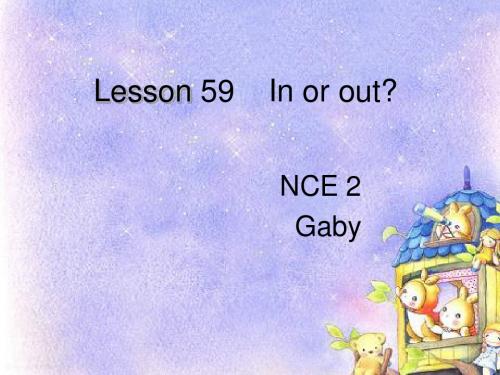
Lesson 59
In or out?
NCE 2 Gaby
press
① v. 按,挤,压
• She pressed my hand warmly.
• ② vt. 挤取,榨取
• If you prefer juice, you can press some oranges.
• ③ vt. 催促,敦促
As the neighbours complained of the noise, my husband spent weeks training him to press his paw on the latch to let himself in. ① complaim of… 抱怨…… ② train sb. to do sth. 训练某人做某事 ③ let sb. do sth. 让某人做某事 let sb. in 让某人进来 ; let sb. out 让某人出去 • let sb. down 让某人失望 ④ press his paw on the latch = press the latch
Every time he wanted to come into the garden he would bark until someone opened the gate.
① every time=when 每当,每次,无论何时 (后面可以是点时间,也可以是段时间) Every time I turn to Page 59, I will remember him. ② until前后都是肯定。
expert
• • • • • v./n. 专家 expert at/in sth. 在某一方面是专家 He experts at football. expert at/in doing sth. 做某一方面是专家 expert at/in opening the door
新概念英语第二册59课课文
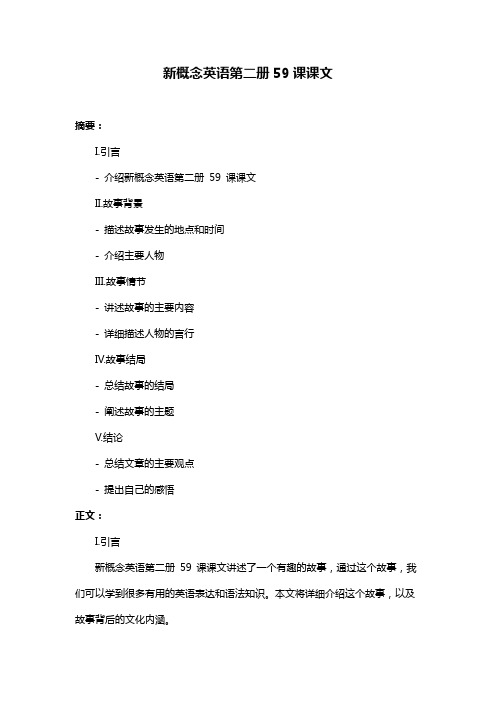
新概念英语第二册59课课文摘要:I.引言- 介绍新概念英语第二册59 课课文II.故事背景- 描述故事发生的地点和时间- 介绍主要人物III.故事情节- 讲述故事的主要内容- 详细描述人物的言行IV.故事结局- 总结故事的结局- 阐述故事的主题V.结论- 总结文章的主要观点- 提出自己的感悟正文:I.引言新概念英语第二册59 课课文讲述了一个有趣的故事,通过这个故事,我们可以学到很多有用的英语表达和语法知识。
本文将详细介绍这个故事,以及故事背后的文化内涵。
II.故事背景故事发生在一个小镇上,时间是早晨。
主要人物包括一个年轻女孩(the girl)和一个卖冰淇淋的男子(the man)。
III.故事情节女孩走在去学校的路上,看到一个卖冰淇淋的男子。
女孩想吃冰淇淋,但是她的零花钱不够。
于是,女孩向卖冰淇淋的男子询问价格。
男子告诉她,冰淇淋的价格是30 便士。
女孩只有20 便士,于是她向男子表示她的钱不够。
然而,男子却表示,如果女孩愿意,他可以以20 便士的价格卖给她冰淇淋。
女孩感到很高兴,但她没有立刻答应。
她告诉男子,她需要考虑一下。
女孩走在回家的路上,心里想着冰淇淋的美味。
她决定回头去找那个卖冰淇淋的男子,买下那支冰淇淋。
当她回到男子身边时,却发现他已经离开了。
女孩感到非常失望,她意识到自己错过了一次机会。
IV.故事结局故事以女孩错过买冰淇淋的机会为结局。
这个结局告诉我们,有时候,机会就在我们面前,但我们需要抓住它,否则就会错过。
故事的主题是珍惜眼前的机会,不要犹豫不决。
V.结论通过这个故事,我们可以学到很多有用的英语表达和语法知识。
同时,故事也告诉我们,珍惜眼前的机会很重要。
新概念英语第二册 lesson 59讲解
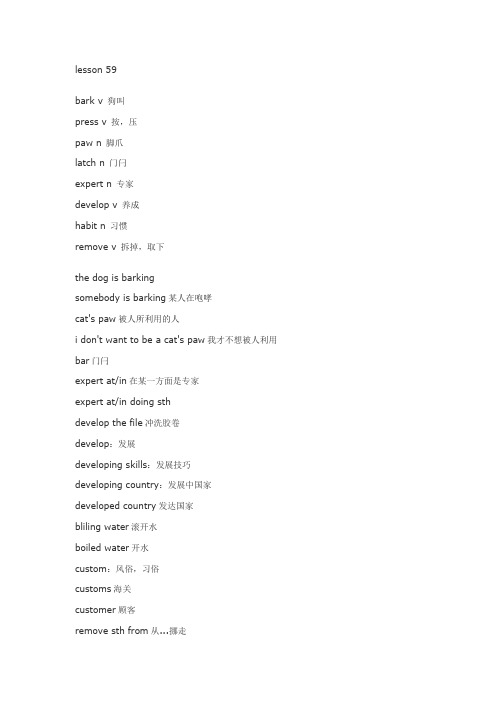
lesson 59bark v 狗叫press v 按,压paw n 脚爪latch n 门闩expert n 专家develop v 养成habit n 习惯remove v 拆掉,取下the dog is barkingsomebody is barking某人在咆哮cat's paw被人所利用的人i don't want to be a cat's paw我才不想被人利用bar门闩expert at/in在某一方面是专家expert at/in doing sthdevelop the file冲洗胶卷develop:发展developing skills:发展技巧developing country:发展中国家developed country发达国家bliling water滚开水boiled water开水custom:风俗,习俗customs海关customer顾客remove sth from从...挪走textOur dog, Rex, used to sit outside ourfront gate and bark. Every time he wantedto come into the garden he would barkuntil someone opened the gate. As theneighbours complained of the noise, myhusband spent weeks training him topress his paw on the latch to let himselfin. Rex soon became an expert at openingthe gate. However, when I was going outshopping last week, I noticed him in thegarden near the gate. This time he wasbarking so that someone would let himout ! Since then, he has developed anotherbad habit. As soon as he opens the gatefrom the outside, he comes into the gar-den and waits until the gate shuts. Thenhe sits and barks until someone lets him out. After this he immediately lets himselfin and begins barking again. Yesterday my husband removed the gate and Rex got so annoyed we have not seen him since.let sb in让某人进来let sb out让某人出去let sb down让某人失望let‘s like let's go and so onfront gatewould=used toevery time=whenthe monment=as soon asthe monment一...就...(强调的是瞬间every time:每次,每当every time i turn to lesson 59,i will remember my teacher complaim of抱怨spend time doing花费某段时间去做某事it takes sb事情做主语sb spend time人做主语train sb to do 训练某人做某事press his paw/press the latchpress the button/press the figure on the buttonso that:以便于,为了(表达目的)so...that...如此...以至于,结果状语从句,可以省略一个词表达目的:to/in order to/in order that/ so as to/so that,to+动词原形,他哈特+从句目的状语从句必须具备一个特征,在动词前面一定要出现情态动词目的状语从句当中不存在want,只有to do非谓语动词的否定形式在结构前面如果发现do的动作不是由主语做的,而是由其他人做的,在to的前面加for sb 不定式的逻辑主语for sb to do sthmultiple choice6、so that引导目的状语从句in case 以防万一,如果EG.:Bring your unbrella in case it rainsso表示结构:引导句子7、as soon as he______...as soon as引导状语从句状语从句中使用一般现在时取代一般将来时be opening强调动作正在发生has been doing现在完成进行时强调从过去延续到现在。
新概念英语第二册59课课文

新概念英语第二册59课课文
新概念英语第二册的第59课是关于"An ideal student"(理想的学生)的课文。
以下是对该课文的多角度全面回答:
这篇课文主要描述了一个理想的学生的特点和行为。
理想的学生应该对学习充满热情,努力工作,并且有良好的学习习惯。
他们应该有高度的自律能力,能够合理安排时间,充分利用每一分钟进行学习。
这样的学生会保持专注,并且能够集中精力解决问题。
理想的学生还应该具备良好的沟通能力。
他们能够与老师和同学们积极互动,参与课堂讨论,并且善于表达自己的观点。
他们也应该有良好的阅读和写作技巧,能够理解和分析各种文本,并能够清晰地表达自己的思想。
此外,理想的学生应该有广泛的知识面。
他们应该对各个学科都有一定的了解,并且能够将不同学科的知识联系起来,形成全面的视野。
他们应该保持好奇心,积极主动地探索新的领域,并且能够将所学知识应用到实际生活中。
除了学术方面,理想的学生还应该具备良好的道德品质。
他们
应该诚实守信,尊重他人,并且具备团队合作精神。
他们应该积极参与社会活动,关心他人,并且有意识地为社会做出贡献。
总而言之,理想的学生应该是一个全面发展的个体。
他们不仅在学术上有出色的表现,还具备良好的沟通能力、广泛的知识面和良好的道德品质。
他们是积极进取、乐于学习和与他人合作的人。
这样的学生将为自己的未来打下坚实的基础,并且对社会做出积极的贡献。
希望以上回答能够满足你的要求。
如果还有其他问题,请随时提问。
新概念英语2Lesson59Inorout
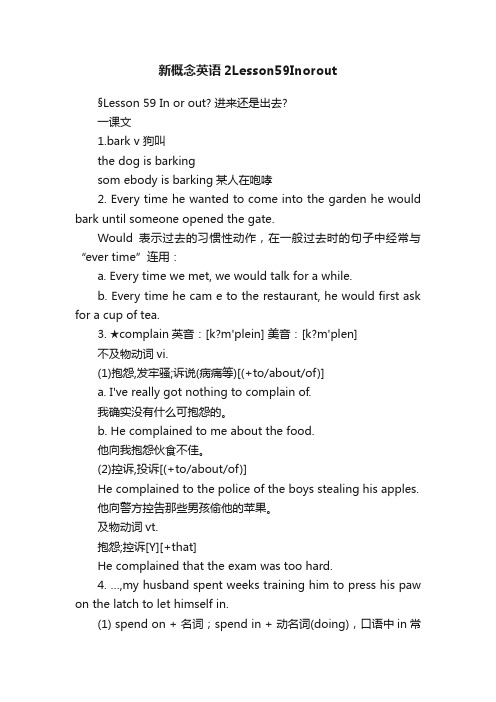
新概念英语2Lesson59Inorout§Lesson 59 In or out? 进来还是出去?一课文1.bark v 狗叫the dog is barkingsom ebody is barking某人在咆哮2. Every time he wanted to come into the garden he would bark until someone opened the gate.Would表示过去的习惯性动作,在一般过去时的句子中经常与“ever time”连用:a. Every time we met, we would talk for a while.b. Every time he cam e to the restaurant, he would first ask for a cup of tea.3. ★complain英音:[k?m'plein] 美音:[k?m'plen]不及物动词vi.(1)抱怨,发牢骚;诉说(病痛等)[(+to/about/of)]a. I've really got nothing to complain of.我确实没有什么可抱怨的。
b. He complained to me about the food.他向我抱怨伙食不佳。
(2)控诉,投诉[(+to/about/of)]He complained to the police of the boys stealing his apples.他向警方控告那些男孩偷他的苹果。
及物动词vt.抱怨;控诉[Y][+that]He complained that the exam was too hard.4. …,my husband spent weeks training him to press his paw on the latch to let himself in.(1) spend on + 名词;spend in + 动名词(doing),口语中in常常省略。
新概念英语第二册_第59课
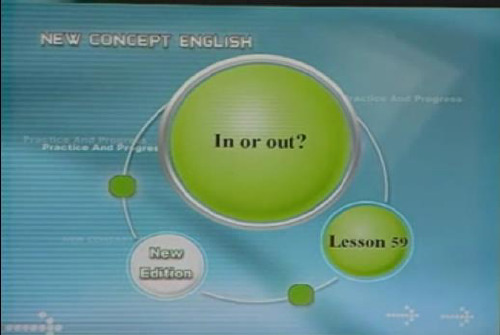
remove v. 拆掉, 取下 • remove the dishes 撤去碗碟 • remove one’s hat 脱掉帽子 • My husband removed the gate. 拆门 • The player was removed from the team. 开除
★
remove
★paw n. 脚爪 • The cat’s paw was burnt. • My dog’s paw was bleeding. • cat's paw 被利用的人(由寓言而来) • I don‘t want to be a cat’s paw. 我才不想被人利用 。
latch n. 门闩 • latch n. 门闩(庭院,花园中的门闩) • bar n. 门闩(与 latch不同) • You can’t walk in because the door is on the latch.
untill
• we’ll stay at home until the rain stops. • We won’t start until the rain stops.
• train sb. to do sth. 训练某人做某事 • →press his paw on the latch = press the latch • press the button = press the figure on the button • →let sb. in 让某人进来 ; let sb. out 让某人出去 •
★
latch
• on the latch 仅上门闩的,关着的,未 上锁的 • off the latch 未上门闩的,虚掩的 2)v. 用门闩栓牢或用撞锁锁住 你离开的时候别忘了把前门锁上。 • Don’t forget to latch the front door when you leave.
新概念第二册第59课时
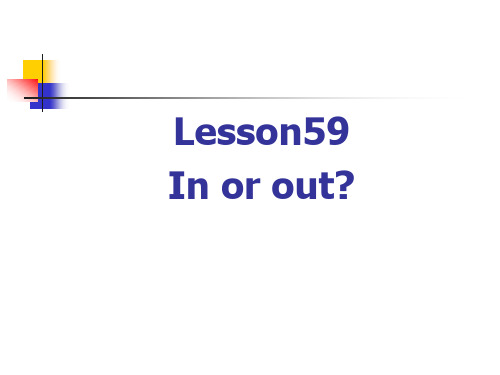
紧迫
Key words & expressions
★paw n. 脚爪 The cat’s paw was burnt. cat's paw 被利用的人 I don‘t want to be a cat’s paw.
我才不想被人利用 。
★ expert n. 专家,能手 adj. 熟练的,老练的
★ an expert in/ at (doing) sth (某方 面的)专家/ 能手
★ be/ become expert in/at (doi译】:
1)他是个老练的司机。 He is an expert in/at driving a car. = He is expert in/ at driving a car. 2)They are all experts in this field. 他们都是这个领域的行家。
Key words & expressions
★develop v. 养成 develop a habit ① vt. &vi. 发展,扩展 The village has developed into a town
now. developing country 发展中国家 ; developed country 发达国家 boiling water 滚开水 ; boiled water
开水
trained animals 驯化了的动物 abandoned farms 废弃了的农场 落叶_fa_l_le_n_l_e_a_v_e_s_____ 正在飘落的树叶f_a_lli_n_g_l_e_a_v_e_s__
Key words & expressions
新概念英语第二册59课课文
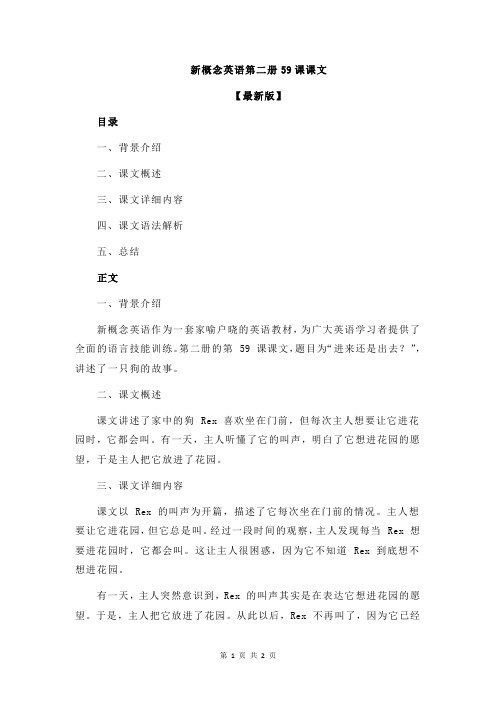
新概念英语第二册59课课文
【最新版】
目录
一、背景介绍
二、课文概述
三、课文详细内容
四、课文语法解析
五、总结
正文
一、背景介绍
新概念英语作为一套家喻户晓的英语教材,为广大英语学习者提供了全面的语言技能训练。
第二册的第 59 课课文,题目为“进来还是出去?”,讲述了一只狗的故事。
二、课文概述
课文讲述了家中的狗 Rex 喜欢坐在门前,但每次主人想要让它进花园时,它都会叫。
有一天,主人听懂了它的叫声,明白了它想进花园的愿望,于是主人把它放进了花园。
三、课文详细内容
课文以 Rex 的叫声为开篇,描述了它每次坐在门前的情况。
主人想要让它进花园,但它总是叫。
经过一段时间的观察,主人发现每当 Rex 想要进花园时,它都会叫。
这让主人很困惑,因为它不知道 Rex 到底想不想进花园。
有一天,主人突然意识到,Rex 的叫声其实是在表达它想进花园的愿望。
于是,主人把它放进了花园。
从此以后,Rex 不再叫了,因为它已经
得到了自己想要的。
四、课文语法解析
本课的语法重点是情态动词的用法。
课文中用到了“would”这个情态动词,表示过去常常发生的动作或存在的状态。
“would”也可以表示一种倾向、习惯或特点。
例如,课文中的句子“every time he wanted to come into the garden, he would bark”(每次它想进花园时,它都会叫),表示 Rex 过去常常在想进花园时叫。
五、总结
通过这个故事,我们学会了要细心观察,了解别人的需求。
新概念英语第二册:第59课课文详解及语法解析

新概念英语第二册:第59课课文详解及语法解析课文详注 Further notes on the text1.Every time he wanted to come into the garden he would bark until someone opened the gate.每当它想到花园里来时,便汪汪叫个不停,直到有人把门打开。
every time在这里为连词引导一个时间状语从句,表示“每次”、“每当”,主句中的would表示过去的习惯性动作。
用一般过去时的句子中它们经常连用:Every time we met, we would talk for a while.我们每次见面都要聊一会儿。
Every time he came to the restaurant, he would first ask for a cup of tea.他每次到这个饭馆来,都是先要一杯茶。
2.…my h usband spent weeks training him to press his paw on the latch to lethimself in.……我丈夫花了几个星期的时间训练它用脚爪按住门闩把自己放进来。
(1)spend表示“在……上花时间”时,后面如果跟名词则用介词on;如果跟动名词则用介词in(在口语中in往往省略):Why don't you spend more time on studies?你为什么不在学习上再多花点时间呢?I spent two weeks(in) reading this book.我花了两星期的时间读这本书。
(2)train的宾语是him, to press…是宾语补足语,to let…为目的状语。
3.Rex soon became an expert at opening the gate.雷克斯很快成了开门的专家。
expert表示“做/干……的专家/高手”时后面通常用 at doing sth.;表示在某一领域是“专家”、“”时可用介词in或on:John is an expert at driving a car.约翰是开车高手。
新概念英语第二册59课课文
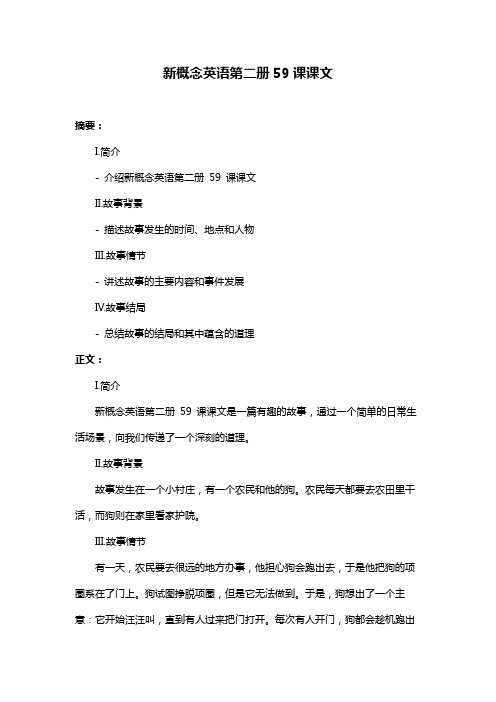
新概念英语第二册59课课文
摘要:
I.简介
- 介绍新概念英语第二册59 课课文
II.故事背景
- 描述故事发生的时间、地点和人物
III.故事情节
- 讲述故事的主要内容和事件发展
IV.故事结局
- 总结故事的结局和其中蕴含的道理
正文:
I.简介
新概念英语第二册59 课课文是一篇有趣的故事,通过一个简单的日常生活场景,向我们传递了一个深刻的道理。
II.故事背景
故事发生在一个小村庄,有一个农民和他的狗。
农民每天都要去农田里干活,而狗则在家里看家护院。
III.故事情节
有一天,农民要去很远的地方办事,他担心狗会跑出去,于是他把狗的项圈系在了门上。
狗试图挣脱项圈,但是它无法做到。
于是,狗想出了一个主意:它开始汪汪叫,直到有人过来把门打开。
每次有人开门,狗都会趁机跑出
去,但是它总会被农民抓回来。
IV.故事结局
最后,农民终于明白了狗的心思,他把项圈解开了。
从此,狗再也没有试图跑出去过。
新概念英语第2册课程讲义Lesson59

Lesson 59 单词讲解1. press v. 按,压press the buttonpress any key to continuen. 出版社,新闻界Foreign Language Teaching and Research Presspressure n. 压力relieve the pressurethe pressure of life / work2. develop v. 养成develop a bad / good habita developing countrya developed countryLesson 59 课文&语法讲解Key points: 复习50-58 课so that … / so … that1. Our dog, Rex, used to sit outside our front gate …2. Every time he wanted to come … he would bark until someone opened the gate.3. As the neighbours complained of the noise, my husband spent weeks training him topress his paw …complain of / about …spend + 时间/钱+on sth. / (in) doing sth.train sb. to do sth.4. … my husband spent weeks training him to press his paw on the latch to let himself in.表示目的:to do / in order to do / so as to doI am coming to see you.5. Rex … became an expert at opening the gate.6. … when I was going out shopping last week, I noticed him in the garden …7. … he was barking so that someone would let him out!so that …He ran to the station so that he caught the train.He ran to the station so that he might catch the train.= in order that7. … he was barking so that someone would let him out!7. … he was barking so that someone would let him out!?… they had taken special precautions so that no one should recognize them.7. … he was barking so that someone would let him out!so that …so … that …The ball struck him so hard that he nearly fell ...His diet was so strict that he had to reward himself …8. Since then, he has developed another … habit.9. As soon as he opens the gate … he comes into the garden … until the gate shuts.10. … my husband removed the gate and Rex got so annoyed (that) we have not seen himsince.11. … my husband removed the gate and Rex got so annoyed (that) we have not seen himsince.Lesson 59 知识拓展表示目的:to doin order to doso as to doHe told you about it to warn you.so that + 句子(有情态动词)in order that + 句子He told you about it so that you would be careful.表示目的:to do / in order to do / so as to doso that / in order that + 句子(有情态动词)He ran to the station. He wanted to catch the last train.He ran to the station to catch the last train.He ran to the station so that he would catch the last train.表示目的:to do / in order to do / so as to doso that / in order that + 句子(有情态动词)The thief ran quickly. The policeman couldn’t catch him.The thief ran quickly so that he policeman couldn’t catch him.I’m trying to break the ______ of getting up too late.A. traditionB. convenienceC. habitD. leisure( 天津10)I’m trying to break the ______ of getting up too late.A. traditionB. convenienceC. habitD. leisure( 天津10)As the story ______, the truth about the strange figure is slowly discovered.A. beginsB. happensC. endsD. develops( 安徽21)As the story ______, the truth about the strange figure is slowly discovered.A. beginsB. happensC. endsD. develops( 安徽21)If a lot of people say a film is not good, I won’t bother to see it, or I’ll wait ______ it comes out on DVD.A. whetherB. afterC. thoughD. until( 上海36)If a lot of people say a film is not good, I won’t bother to see it, or I’ll wait ______ it comes out on DVD.A. whetherB. afterC. thoughD. until( 上海36)。
新概念英语第二册第59课 In or out 进来还是出去
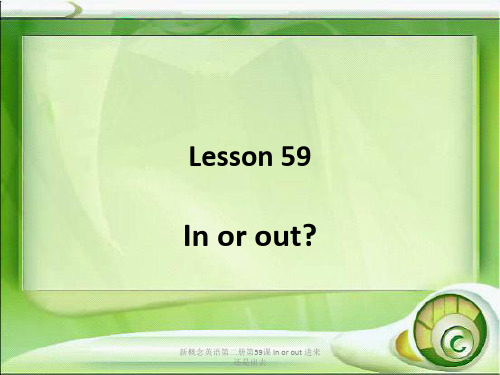
新概念英语第二册第59课 In or out 进来 还是出去
9
Watch the story and answer the following questions.
• (1) What did our dog use to do? • (2) Why did he bark like that? • (3) Why did your husband train him to let him in? • (4) What did you find when you were out for
11
★bark
v 狗叫
• 狗在叫。
• the dog is barking
• 那只狗老是对我叫
• That dog always barks at me.
• somebody is barking
• 某人在咆哮
• A barking dog seldom bites.
• (谚)善吠之犬不咬人
新概念英语第二册第59课 In or out 进来 还是出去
新概念英语第二册第59课 In or out 进来 还是出去
15
• ★expert n. 专家 • expert on/in sth. 在某一方面是专家 • expert at doing sth. • 他是数学专家。 • He is an expert in maths. • 他是开锁专家 • He is an expert at opening the door.
• He walked so fast that he didn't notice his wife.
新概念英语第二册第59课 In or out 进来 还是出去
24
新概念英语NCE2_Lesson59(共18页)课件

• 1.闩上;用碰锁锁上
• 2.抓住;占有;理解[(+onto/upon)]
• John was very lucky to have latched onto the office with a river view. 约翰非常幸运,占了一间能看到河的办公室。
• expert:专家 ;能手;熟练者[(+at/in/on)] • She is an expert in training animals.
to do不定式做目的状语
•
for sb to do sth = so that sb. do sth.
•
7. As soon as he____...
•
Answer B
•
as soon as 引导状语从句
•
状语从句中使用一般现在时取代一般将来时
•
be opening 强调动作正在发生
•
has been doing 现在完成进行时强调从过去延续到现
•
表达目的:to/in order to /in order that/ so as to /so
that
•
to + 动词原型, that+从句
•
目的状语从句必须具备一个特征:在动词前面一定
要出现情态动词
• 【Special difficulties】
•
表达目的的几种方式 :to/in orderto
• 2.脱掉;去掉,消除[(+from)] • She saw he had removed his glasses.
她看到他摘下了他的眼镜。 • 3.使离去;把...免职撤去[(+from)] • He was removed from the post.
新概念英语第二册 Lesson 59课件

新概念英语第二册第59课

Key structures and usage
表示目的的几种方式: to, in order to, so as to, so that, in order that →My husband spent weeks training him to →We start out early in latch to let himself in. press his paw on the order to avoid traffic. →I moved to the front of the bus so as to get →This time he was barking so that someone a good view of the countryside. would let him out. →He left the letter on the table in order that I might see it.
★expert n. 专家 expert at/in sth. 在某一方面是专家 expert at/in doing sth. She is an expert in cosmetic.
Key words & expressions
★develop v. 养成 develop a habit ① vt. &vi. 发展,扩展 The village has developed into a town now. developing country 发展中国家 ; developed country 发达国家 V-ed 强调已经,V-ing 强调正在,有时态的区别 boiling water 滚开水 ; boiled water 开水
Language points
- 1、下载文档前请自行甄别文档内容的完整性,平台不提供额外的编辑、内容补充、找答案等附加服务。
- 2、"仅部分预览"的文档,不可在线预览部分如存在完整性等问题,可反馈申请退款(可完整预览的文档不适用该条件!)。
- 3、如文档侵犯您的权益,请联系客服反馈,我们会尽快为您处理(人工客服工作时间:9:00-18:30)。
新概念英语第二册:第59 课课文详解及语法解析课文详注 Further notes on the text
1.Every time he wanted to come into the garden he would
bark until someone opened the gate. 每当它想到花园里来时,便汪汪叫个不停,直到有人把门打开。
every time 在这里为连词引导一个时间状语从句,表示“每次”、“每当”,主句中的 would 表示过去的习惯性动作。
用一般过去时的句子中它们经常连用:
Every time we met, we would talk for a while.
我们每次见面都要聊一会儿。
Every time he came to the restaurant, he would first
ask for a cup of tea.
他每次到这个饭馆来,都是先要一杯茶。
2.my husband spent weeks training him to press his paw
on the latch to let
himself in. 我丈夫花了几个星期的时间训练它用脚爪按住门闩把自己
放进来。
(1)spend 表示“在上花时间”时,后面如果跟名词则用介词on; 如果跟动名词则用介词 in( 在口语中 in 往往省略 ) :
Why don't you spend more time on studies?
你为什么不在学习上再多花点时间呢?
I spent two weeks(in) reading this book.
我花了两星期的时间读这本书。
(2)train 的宾语是 him, to press 是宾语补足语, to let 为目的状
语。
3.Rex soon became an expert at opening the gate.雷克斯很
快成了开门的专家。
expert 表示“做 / 干的专家 / 高手”时后面通常用 at doing sth.;
表示在某一领域是“专家”、“”时可用介词 in 或 on:
John is an expert at driving a car.
约翰是开车高手。
She is an expert in flowers.
她是花卉方面的专家。
Sam is an expert on that problem.
萨姆是研究那个问题的。
4.This time he was barking so that someone would let him
out! 这次它叫着让人把它放出去!
连词 so that引导的是目的状语从句。
(cf. 本课语法 )
语法 Grammar in use
1.复习第 50~58 课语法
He's having lunch , isn't he?
他正在吃午饭,是不是?( 现在实行时表示说话时正在实行的动作) Yes,he always has lunch at this time of the day.
是的,他每天总是在这个时间吃午饭。
( 一般现在时表示习惯性
动作 )
She's reading a book,isn't she?
她正在读一本书,是不是?
Yes,she's been reading the book all morning.
是的。
她整个上午一直在读这本书。
( 现在完成实行时强调动作的持续性 )
I was told that ships were built here.
我听说这里造过船。
( 被动语态 was told 表示说话谨慎 ; 从句中的一般过去时表示不知现在是否仍造船 )
They used to be built here,but they aren't any more.
过去这里是造过船,但现在不造了。
(used to 在已终止的状态,强调过去与现在的对照,所以不可用表示过去有过但现would 代替 )
You've taken your time! What on earth have you
been doing?
你可真够慢约 ! 你到底一直在干什么 ?(on earth用于表示强调) I'm sorry.We got caught in astorm.
对不起。
我们遇上一暴风雨了。
( 在口语中 get+ 过去分词相当于被动语态 )
2.表示目的的几种方式: to, in order to, so as to, so that,
in order that
(1) 带 to 的不定式及其变体 in order to 和 so as to 能够用来表示目的:
I went to live in France to/in order to/so as to learn
French.
我去法国居住,以便学习法语。
not to能够用于表示取舍:
I went to France not to study French, but to
study chemics.
我去法国不是为了学法语,而是为了学化学。
so as not to/in order not to能够用于表示“以防”:
I shut the door quietly, so as not to/in order not
to wake the baby.
为了不惊醒婴儿,我轻轻地关上门。
在 bring, buy, need, take, use, want 不定式 ( 而不用宾语 +in order to/so as to) 的:
等动词后经常用宾语 + ,不定式表示用宾语的目
I want something to drink.
我想要一点喝的东西。
I need a spoon to eat this ice cream with.
我需要一把汤匙来吃这冰淇淋。
Bring me a chair to sit on.
给我拿一把椅子来坐。
(2) 连词 so that, in order that能够引导目的状语从句。
当主句用一般现在时、现在完成时或一般将来时的时候,so that和in
order that 后面能够跟may, can 或will 。
so that 比in order that 更为普遍:
I've arrived early so that/in order that I
may/can/will get the tickets.
我到得早,以便能买到票。
当主句中的动词为一般过去时、过去实行时或过去完成时的时候,so that 和 in order that 后面跟 should, could,
might 或 would:
I arrived early so that/in order that I
should/could/might/would get the
tickets.
( 译文同上 )
so that和in order that后面的否定形式如下:
I arrived early so that/in order that I might not miss
anything.
我到得很早,以免错过什么。
( 否定句中不可用could, 可用
等)
should, would
(3) 相比之下,带to, so as to 和in order to 的结构比带
that 的结构要简单、自然,所以多为人使用:
I arrived early so as not to/in order not to
miss anything.( 译文同上 )
当前后主语不一致时,不定式前面加for+ 名词 / 代词比that 结构更简洁:
I bought a new car in order that/so that my wife might
learn to drive.
我买了一辆新车,以便我妻子学习驾驶。
I bought a new car for my wife to learn to drive. ( 译文同上 )。
